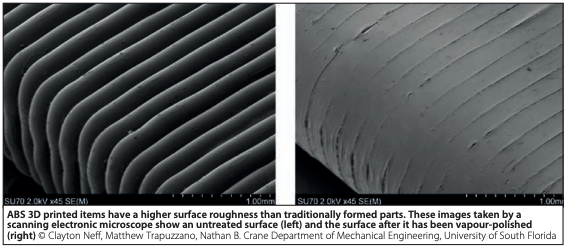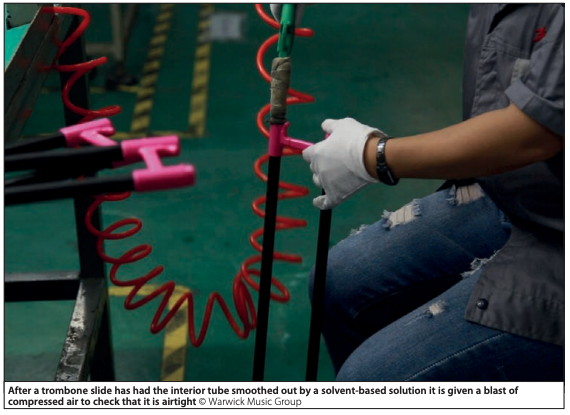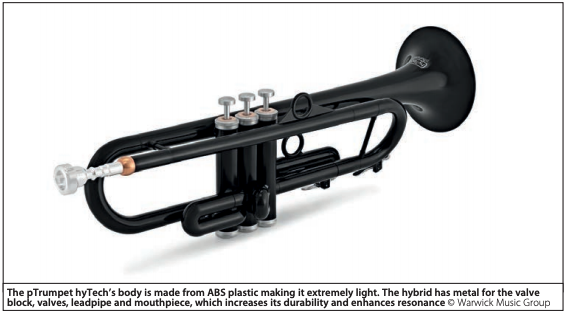From Brass To Recyclable Plastic; Reinvention Of Musical Instruments
June 2nd, 2020 | 8 min read

Originally published in issue 82 of Ingenia, the Royal Academy of Engineering’s quarterly magazine (www.ingenia.org.uk)
'A quarter of a million brightly coloured trombones made of recyclable ABS plastic have been sold worldwide in the last few years. The pBone, weighing less than a kilogram and costing a tenth of its metal cousin, has driven a demand for a range of polymer-made instruments including a trumpet. Rachel Jones spoke to Warwick Music Group’s CEO, Steven Greenall, and Innovation Director, Chris Fower, about the engineering hurdles that were overcome to enable this success.
The pBone journey began with an experiment developed by an engineering design student, Hugh Rashleigh, at Loughborough University. An amateur trumpeter, he was inspired by a peer-reviewed PhD paper from the 1980s suggesting that the surface quality in brass instruments could be as influential as the metal itself for sound quality. Rashleigh made a prototype trombone for his undergraduate project that, through an introduction to Steven Greenall – a venture capitalist and entrepreneur with a degree in electrical engineering – formed the basis of the pBone.
Greenall was a trombone player and owner of the music publisher Warwick Music Limited. He was interested in widening access to music education and saw a strong market proposition in Rashleigh’s prototype. If a trombone of acrylonitrile butadiene styrene (ABS) plastic could retain a traditional instrument’s features while lessening cost, maintenance and propensity for damage then it would have strong business potential.

While the pBone was not intended for professional orchestras, it would have to be good enough to convince music teachers and get young people interested. Chris Fower, a professional trombonist and consultant involved in high-end trombone design, was brought in to help develop the project. Making a trombone from polymer would involve a matrix of design, engineering and manufacturing challenges.
Lateral Thinking
Like trumpets, trombones produce sound by generating air vibrations in a tubular resonator. An extendable slide changes the tubing length and alters the harmonic series available. The slide itself comprises two parallel, stationary inner tubes and two movable outer tubes. “It’s the trombone’s weak spot, with two soft metals running over each other,” Fower explains. “If you bash it, it’s hard to repair – which can make the metal trombone a costly choice for children.”
Rashleigh’s solution for the slide drew on fibreglass manufacturing methods. A non-metallic material could potentially make the slide lighter, stronger and bash resistant, but it would need engineering to remain stiff, light and parallel. “A metre-long piece of tubing with a wall thickness of 0.5 millimetres, that needs to be turned completely straight and completely rigid, is hard to engineer out of anything,” says Fower. Experimenting with extruded plastics brought issues of longitudinal torsion and tolerancing into play.
To solve this, Rashleigh looked into the manufacture of fibreglass fishing rods. For these, a resin-impregnated glass cloth is wrapped tightly over a mandrel, rolled under high pressure and baked in order to melt the resin to a solid mass. Rashleigh adapted this to create his own solution for the slide. “That bit of engineering was great lateral thinking,” says Fower.

Seed funding of £90,000 from Advantage Creative Fund in 2008 enabled investment in newly-affordable computer-aided design and 3D printing. The trio began extensive testing, using players to trial prototypes containing ABS 3D-printed components. Focusing on separate parts of the instrument, they tested prototypes and tracked the benefits of each alteration. The sound quality was extremely uneven. “We had areas of low definition where it was insecure and muffled. The polymer helped produce quite a warm, dull, mellow sound, but clarity and precision were needed,” says Fower. “It was necessary to find out and deliver the overtones that metal instruments could offer.”
Altering the interior shape was vital in helping improve the sound quality, especially in areas of the prototype where the air changed direction, at the end of the slide and bell, or anywhere the pipe constricted or opened up. Experiments with 3D printing demonstrated how the shape of components could improve acoustic qualities and help the plastic to resonate. Their work led to a first patent, filed in 2010, and used in all subsequent instruments. This was “essentially about varying wall thickness, using a polymeric material, to impact acoustic sound,” says Greenall, who defended it in 2017 against a Chinese rival.
The notion that surface quality could be as influential as underlying material drove development. Most injected plastic parts have ‘A’ and ‘B’ surfaces, but something more than a ‘B’ surface was needed to replicate a brass instrument’s polished interior tube. “Under a microscope, the ABS 3D printing looked like shredded wheat,” recalls Fower. “It mimicked the shape but not the surface quality or material integrity. Blowing through, the air dissipated and it sounded pretty horrible.” Overcoming this required a number of experiments in order to develop a solvent-based system to seal the surfaces and make them airtight.
From 2007 to 2010 the trio experimented with methods including sintering – the process of compacting and forming a solid material by heat or pressure without melting it to the point of liquefaction – and stereolithography, a form of 3D-printing. Another issue that was sorted out before production was bacterial growth. Brass trumpets contain raw nickel (a natural antimicrobial) but polymer-made instruments had antimicrobial additives incorporated.
By 2009, a manufacturing facility in China agreed to take on the instrument. The trio began moving to production, transferring printed shapes into engineering files, and creating tools. “We’d worked out where struts were going to go, shapes of turns, all of that,” says Fower. The pBone’s launch in late 2010 saw the first stock of 500 instruments sell out in 19 minutes. Since then, Warwick Music Group has sold more than 250,000 units worldwide, and in 2019 the pBone won the Queen’s Award for Enterprise: Innovation.
Developing The Ptrumpet
As Rashleigh stepped back from development, the team began work on the pTrumpet. Having solved acoustic issues in the pBone, they were ready to address the trumpet’s greater challenges. One of the main obstacles lay around achieving acceptable tolerance (limits of variation) in piston valves. “The trumpet is half the length of a trombone, so the acoustic challenge was easier to deal with,” notes Fower.
The modern trumpet valve, invented in the early 19th century, allows players to control the passage of breath, rerouting air through additional tubing, and altering the pitch. As with the trombone, there have been a few innovations. The pair set themselves the target of replacing the metal valve system with one made entirely of plastic. “It was like making a combustion engine – in plastic.”
Their original design scheme, making the system using only ABS injection moulding, proved unworkable. Injecting could lower costs and drive up repeatability, but for pistons, they couldn’t inject to the tolerance required. Instead, CNC-machining (automated control of machining tools and 3D printers through a computer) allowed the pair to alter tolerances incrementally, and reduced cost. Pistons could be made from a single bar of polyoxymethylene – POM, a crystalline polymer.

The varying temperature conditions on a production line presented a particular challenge. Small changes in temperature caused big problems. “If a valve block is cut at 20 degrees and a piston at 25 degrees, they won’t fit together, or there’ll be big holes.” The solution was to move everything into a temperature-controlled environment to sit for 48 hours before being machined. Even then, machining plastic was not simple. “A compression wave follows the cut and pushes material out of the way,” says Greenall. “It’s difficult to get it thin.”
Unlike handmade brass piston systems, the pTrumpet would be mass-produced. ‘Lapping’ – the manual process for honing brass, and improving an instrument’s tonal quality – was especially hard to replicate. “In brass, you make inner and outer parts then hand-lap one of those two components until they fit,” explains Fower. “The more expensive a brass trumpet, the more hand lapping.” In polymer, success rested on good choices of material and precision in mass manufacture. This involved keeping close to suppliers to learn what was possible and make the process fully repeatable. “We pushed the weak spots around until we found a workable balance of tolerance and repeatability. The valve production is very repeatable now, and produces a surprisingly playable result.”
With no competitors or research to inform the work, Fower and Greenall made “a few thousand trumpets that weren’t good enough” before getting it right. Fower gives the example of air leakage from a prototype valve block. “Let’s say it gave two litres a minute leakage at five bar [unit of pressure]. We’d design the rest of the instrument around that, but when we got into manufacturing and it leaked at 10 litres a minute, the adjustments went out of the window. We didn’t know what real leakage was until we made it in a factory.” As with the pBone, tiny changes had large impacts. “Making thousands of exactly the same thing, such as pistons, meant we got better and better at making them.” Mass manufacture offered enormous benefits, bringing the pTrumpet to children who could not otherwise afford to play, but “when you mass manufacture in plastics, it’s hard to get a perfect prototype and build it. Instead, we had to learn how to build it – by building it”.
Launched in September 2014, the pTrumpet weighed just 500 grams and was an immediate hit. “It looks and sounds like brass at half the price,” said The Spectator. With its universal valves (replaceable in any holes) and ability to operate without lubrication, it was a game-changer for music teachers teaching large groups.
A Hybrid Trumpet
The pTrumpet’s all-plastic system did not totally overcome the lack of compression. Escaping air makes tonal quality less focused, and can negatively affect intonation and timbre. Since the base sound quality of polymer-made instruments leans toward being warmer and less focused than brass, this leakage is particularly difficult to carry. Yet making plastic to the tolerance of 0.005 millimetres – possible with brass – was impractical commercially.
The limitations of a polymer-only solution drove Greenall and Fower to work on a hybrid: the hyTech. They aimed to retain the pTrumpet’s lightweight robustness while improving playability and sound quality by adding metal where polymers “couldn’t cut it at the price point”. Fower adds: “We’d become experts in the limits of where plastics technology could take us within reasonable budgets, so we began to think about different choices of material to create enhanced resonance.”

Valves were again the main challenge. Using metal to achieve airtightness would improve performance, but meant a higher price and more manufacturing complexity. The hyTech would feature a valve block made of CNC-cut yellow brass bonded into a polymer casement. The ABS plastic pistons were sleeved with stainless steel and ground to tolerance, then hand-lapped into the brass of the valve block. “The brass tubes needed to be CNC-machined to the correct dimensions within a very tight tolerance, held parallel with infilled ABS material shot around them in plastic injection mould,” says Fower. “So we had to work out how to align three brass cylinders while surrounding them with strong polymer.”
It was crucial to define clear parameters for tolerancing and work closely with players and engineering manufacturing partners. Professional trumpeter Joshua MacCluer, former principal trumpet of the Hong Kong Philharmonic, helped to test prototypes. “We wanted a very tight fit on the valves to minimise air leakage and maximise sound quality, so we spent time with the factory quality staff, teaching them how to spot valves that needed reworking.” Players need the ability to attain predictable resonance at a high level of action, explains Fower. “The amount of leakage in valves is really important. Metal-on-metal interaction in the system gives better compression, and that makes a player more secure in the 3D matrix of the harmonics.” The hyTech would achieve valve tolerances of just .005 millimetres per side.
Fower and Greenall also developed a high-quality mouthpiece from brass with three-micron silver plating. The innovative element is in the way the receiver – the hole the mouthpiece goes into – is made. Normally in brass instruments, this tube is forced onto a mandrel two ways and manipulated, to get a double release. With the hyTech, the company CNC-mill the receiver from a solid bar of brass, and inject the internal shape. This means it has far more mass. Instead of using one or two thin bits of tube, a bar is used that allows for greater wall thickness and accuracy, as well as repeatability and consistency of finish.
Another bonus is that because the new receiver has more mass, it helps to centre the tone, while repeatability means the mouthpieces consistently fit with the right gap to make the notes stand up properly. Fower says: “It’s simple engineering by modern standards, but we re-imagined how to make that part.”
What’s Next?
Since 2016, with the help of a second venture capital investor, Midven, Warwick Music Group has invested £1 million in R&D. It launched the hyTech in 2019 and now has eight instruments in its portfolio, including a brass starter (pBuzz) that retails at just £15. Principal markets are currently the US, Europe and Japan and further instruments are being developed with another patent soon to be filed.
With few competitors, what has been the secret to its success? “We came in from the musical angle,” says Fower. “An engineer can say ‘I’ve created the perfect trumpet’ but everything comes down to the sound. We had a deep understanding of why we were making this product, and we combined this with innovative thinking about materials and consultation with suppliers to transmit the ‘why’. By bringing artists and engineers together, we made sure the conversation went straight and productively down the line.”
Listen to hyTech here.
Originally published in issue 82 of Ingenia, the Royal Academy of Engineering’s quarterly magazine (www.ingenia.org.uk)
To download the PDF of this article please visit https://www.ingenia.org.uk/getattachment/Ingenia/Issue-82/Trumpets/Trumpets.pdf


